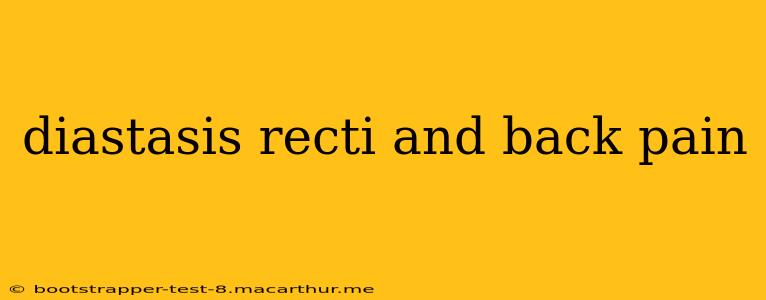Diastasis recti, the separation of the abdominal muscles, is a common postpartum condition affecting many new mothers. While often associated with abdominal discomfort and aesthetic concerns, many women also experience back pain alongside diastasis recti. This article explores the connection between these two conditions, explaining why diastasis recti can lead to back pain and offering strategies for managing both.
What is Diastasis Recti?
Diastasis recti occurs when the rectus abdominis muscles, the "six-pack" muscles, separate at the linea alba, the connective tissue that runs down the midline of the abdomen. This separation is typically caused by the stretching of the abdominal wall during pregnancy to accommodate the growing uterus. While it's a natural part of pregnancy for many, an excessive separation can lead to various problems, including back pain.
How Does Diastasis Recti Cause Back Pain?
The relationship between diastasis recti and back pain is complex but stems from the weakened core support provided by separated abdominal muscles. Here's how it works:
-
Increased Load on the Spine: When the abdominal muscles are separated, they can't effectively stabilize the spine. This increased instability forces other muscles, particularly the back muscles, to work harder to compensate. This overcompensation can lead to muscle strain, fatigue, and pain.
-
Altered Posture: A weakened core can negatively impact posture, leading to an anterior pelvic tilt. This posture shifts the center of gravity, increasing the strain on the lower back and potentially leading to pain.
-
Increased Stress on the Pelvic Floor: Diastasis recti often coincides with pelvic floor dysfunction. A weakened pelvic floor adds further instability to the core, indirectly contributing to back pain.
-
Muscle Imbalances: The body compensates for the weakness in the abdominal muscles by overusing other muscle groups, creating muscle imbalances that can contribute to back pain.
What are the symptoms of diastasis recti?
Many women experience a visible bulge or ridge down the midline of their abdomen, especially when performing activities like sit-ups or crunches. Others may notice a feeling of weakness or instability in their core, difficulty maintaining good posture, or low back pain. The degree of separation and severity of symptoms vary significantly between individuals.
How is diastasis recti diagnosed?
A healthcare professional, such as a physical therapist or OB/GYN, can diagnose diastasis recti through a physical examination. They will assess the separation of the abdominal muscles by feeling the abdomen while the patient performs specific movements. While imaging techniques like ultrasounds are sometimes used, they aren't always necessary for diagnosis.
Can diastasis recti be treated?
Yes, diastasis recti can be treated effectively through a combination of conservative methods. These include:
-
Physical Therapy: A physical therapist can guide you through exercises to strengthen the core muscles and improve pelvic floor function, focusing on proper breathing techniques and targeted exercises to close the gap safely and effectively.
-
Postural Correction: Maintaining good posture throughout the day can significantly alleviate back pain. This involves conscious effort to stand and sit tall, keeping the shoulders back and the abdomen engaged.
-
Lifestyle Modifications: Avoiding activities that exacerbate the condition, such as heavy lifting or high-impact exercise, can be beneficial. Adopting a healthy lifestyle, including balanced nutrition and regular exercise, can support overall healing.
-
Specific Exercises: There are several exercises specifically designed to address diastasis recti. It is crucial to perform these exercises correctly to avoid further injury. Consulting with a qualified healthcare professional is essential to develop a tailored exercise plan.
Can diastasis recti cause chronic back pain?
While many women experience improvement in their back pain with appropriate treatment, in some cases, diastasis recti can contribute to chronic back pain if left untreated. The ongoing instability and muscle imbalances can perpetuate the cycle of pain and discomfort. Early intervention is vital to minimize the risk of chronic issues.
What other conditions might cause back pain along with diastasis recti?
It is important to rule out other potential causes of back pain, even in the presence of diastasis recti. These might include muscular strains, spinal issues, or other underlying medical conditions. Consulting with your healthcare provider is crucial for an accurate diagnosis and management plan.
By understanding the connection between diastasis recti and back pain, women can proactively address both issues and improve their overall health and well-being. Remember, seeking professional guidance from a healthcare provider is crucial for accurate diagnosis and a personalized treatment plan. Early intervention and consistent adherence to a rehabilitation program are essential for successful recovery.
